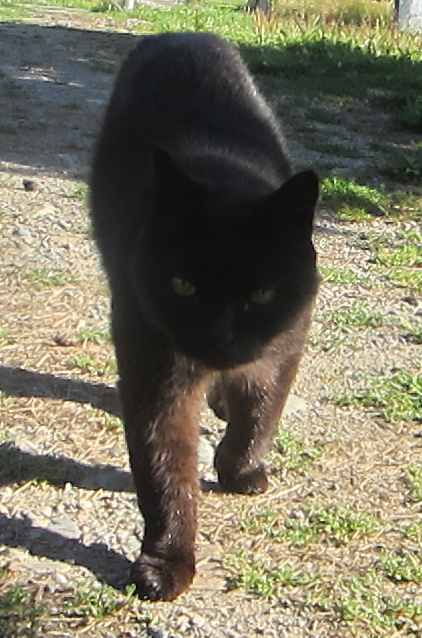|
Afro-Asiatic "kaddiska" -> Late Latin "catus" -> Old English "catt"
Animailia -> Chordata -> Mammalia -> Carnivora -> Felidae -> Felis -> F. Catus Proailurus, the first true cat, emerged 20 million years ago.
Hypercarnivore, diploid, 38 chromosomes, ~20K genes, digitgrades (walk on toes), directly register (place each hind paw almost directly in the print of the corresponding forepaw), pacing gait (moving both legs on one side of the body before the legs on the other side move, a trait shared with camels and giraffes), protractable claws, can tolerate quite high temperatures, do not sweat, have a general lack of circadian rhythms, can survive on a diet only of meat with no additional water (can even rehydrate by drinking seawater), require a diet containing arginine and taurine, have excellent night vision (requiring only 1/6 the light level needed by humans, partially the result of having a tapetum lucidum) but rather poor color vision, have excellent hearing (frequency range 55Hz-79KHz, higher than either humans or dogs) and an acute sense of smell, cannot taste sweetness, have reflexes 6 times faster than humans (20-70 ms versus 150-300 ms), can jump 9 times their own height, live between 12 and 14 years for indoor males, are seasonally polyestrous (may have many periods of heat beginning in spring and ending in late autumn), are superfecund (different kittens in a litter may have different fathers), gestation period of 66 days on the average, reach sexual maturity at 5-10 months for females and 5-7 months for males, can have 2-3 litters per year, are cosmopolitan and can be found on every continent except Antarctica, have obstacle memory for back legs which remembers the height of the front foot after it's lifted and raises the rear foot to the same height, can react to stimulus in 20-70 milliseconds (versus a human's 150-300 milliseconds), can jump 9x own height, and prefer a leftward sleeping position. Recent DNA studies suggest that most of the estimated 600 million domestic cats now living around the globe are descendants most directly of the Near Eastern Wildcat, one of the five Felis Sylvestris Lybica wildcat subspecies still found around the Old World. August 17th is National Black Cat Appreciation Day. October 27th is National Black Cat Awareness Day. |

My 4-footed best friend. 2001 - 2016 |
The Naming of Cats is a difficult matter, It isn't just one of your holiday games; You may think at first I'm as mad as a hatter When I tell you a cat must have THREE DIFFERENT NAMES. First of all, there's the name that the family use daily, Such as Peter, Augustus, Alonzo or James, Such as Victor or Jonathan, George or Bill Bailey, All of them sensible everyday names. There are fancier names if you think they sound sweeter; Some for the gentlemen, some for the dames; Such as Plato, Admetus, Electra, Demeter, But all of them sensible everyday names. But I tell you, a cat needs a name that's particular, A name that's peculiar, and more dignified, Else how can he keep up his tail perpendicular, Or spread out his whiskers, or cherish his pride? Of names of this kind, I can give you a quorum, Such as Munkstrap, Quaxo, or Coriopat, Such as Bombalurina, or else Jellylorum, Names that never belong to more than one cat. But above and beyond there's still one name left over, And that is the name that you never will guess; The name that no human research can discover But THE CAT HIMSELF KNOWS, and will never confess. When you notice a cat in profound meditation, The reason, I tell you, is always the same; His mind is engaged in a rapt contemplation Of the thought, of the thought, of the thought of his name: His ineffable effable, Effanineffable, Deep and inscrutable singular Name. - T. S. Eliot |